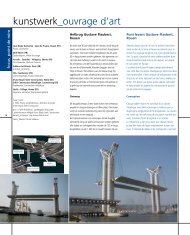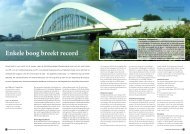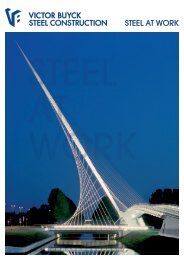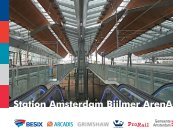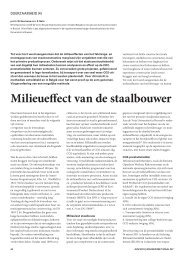environmental implications of steel bridge construction
environmental implications of steel bridge construction
environmental implications of steel bridge construction
You also want an ePaper? Increase the reach of your titles
YUMPU automatically turns print PDFs into web optimized ePapers that Google loves.
Lately, and due to the global warming issue, every sector <strong>of</strong> the industry has been forced<br />
(sometimes by law, sometimes by contract, sometimes but rarely voluntarily) to determine<br />
and measure its <strong>environmental</strong> impact, mostly defined by the energy consumption (in GJ) and<br />
the CO2 emissions (in kg CO2 equivalent). Some other parameters, such as the ozone depletion<br />
potential and the acidification potential (to name only two), are sometimes also included.<br />
Based on these values, certain industries have developed important programmes to cut down<br />
their <strong>environmental</strong> impact through innovation and new processes.<br />
The western <strong>steel</strong> production industry (<strong>steel</strong> mills) has been the leader in the <strong>steel</strong> <strong>construction</strong><br />
sector. Today, through Environmental Product Declarations (EPD), the <strong>environmental</strong><br />
impact <strong>of</strong> most <strong>of</strong> the <strong>construction</strong> materials and products is known and available. They<br />
are “cradle to gate” and correspond with the mandatory information modules A.1 to A.3 <strong>of</strong><br />
EN 15804 [2].<br />
For fabricated structural <strong>steel</strong> products (other than standardised products such as sheeting,<br />
sandwich panels, etc.), this information is still not available in a detailed way. The main reason<br />
is related to the fact that the impact values for fabricated <strong>steel</strong> structures is very much depending<br />
on the degree <strong>of</strong> complexity <strong>of</strong> the structure, which can range from lightweight structures<br />
(handrails) over midweight structures (beams and columns for lightweight buildings) to<br />
heavyweight structures (beams and columns for heavy industrial buildings and high rise <strong>of</strong>fice<br />
buildings) and super heavyweight structures (such as heavily welded <strong>bridge</strong>s).<br />
In the industry, it has been assumed in the past that the <strong>environmental</strong> impact <strong>of</strong> the fabrication<br />
(and erection) process is only marginal if compared to the impact <strong>of</strong> the primary <strong>steel</strong><br />
production process in the mills. Recently, at the Vrije Universiteit Brussel, research has been<br />
done in order to determine the different steps <strong>of</strong> the fabrication and erection process and its<br />
<strong>environmental</strong> impact (in terms <strong>of</strong> energy consumption and global warming potential) [1].<br />
The research has started with the super heavyweight structures, which are (heavy) <strong>steel</strong> <strong>bridge</strong>s.<br />
More and more <strong>bridge</strong> owners (mostly the departments <strong>of</strong> Public Works and the national<br />
railway bodies) are conscious about the <strong>environmental</strong> impact <strong>of</strong> the infrastructure works they<br />
construct. Some <strong>of</strong> them have already implemented the requirement for contractors to be conscious<br />
about the CO2 emissions <strong>of</strong> their operations. ProRail, responsible for the Dutch railway<br />
network, has i.e. initiated the CO2 performance ladder [3], based on a fixed set <strong>of</strong> requirements:<br />
A. Insight (into own carbon footprint);<br />
B. CO2 reduction (recorded ambition);<br />
C. Transparency (internal and external communication);<br />
D. Participation in initiatives (with colleague companies in the field <strong>of</strong> CO2 reduction).<br />
A contractor can be classified into one <strong>of</strong> the five levels <strong>of</strong> the performance ladder. In order<br />
to qualify (and get certified) for level 3, the company is required to report on its scope 1<br />
(direct emissions) and 2 (indirect emissions such as due to electricity consumption and business<br />
travel) CO2 emissions in accordance with ISO 14064-1 and to have quantitatively formulated<br />
objectives for reducing these CO2 emissions. The company is also required to communicate<br />
the above mentioned objectives both internally and externally and to have an active<br />
role in (sector) initiatives relating to climate change.<br />
2



